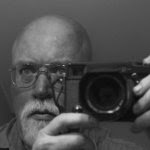Pentax K100D and Sigma 30/1.4 DC EX
- I like the look of film images.
- Digital has not performed well in dim available light.
- Fast normal lenses on a dSLR become fast short telephoto lenses when you consider the crop factor.
What I was having difficulty replicating in the digital world was what I can do with a Leica M6 and 50/1.4 Summilux or 40/1.4 Nokton on TRI-X film. I like shooting wide open with a normal lens in dim light on medium speed black and white film. The lenses of digicams are so very short in focal length, it is hard not to get everything in focus. And under dim light, the noise produced is appalling. I hoped for a digital rangefinder that would accept my lenses at their nominal focal length, but that doesn’t seem to be possible from an engineering standpoint; the angle of the light is too acute at the edges, and a 24x36 sensor is beyond my means anyway. At least these were my excuses for the past few years.
Enter the Pentax K100D. This marvel has a sensor that moves to compensate for camera shake. Thus, one doesn’t have to shoot at a noisy ISO 800 or 1600 when in dim light. The anti-shake allows handheld shooting at 1/16 second. Well, that changes things. Now if I only had a fast 40-50mm lens, something around f/1.4. Enter the Sigma 30/1.4. With the 1.5 crop factor of the Pentax, have a focal length emulating a 45mm lens in the film world. A fast one.
I have to tell you that I’m impressed with both camera and lens. The Pentax is compact and light compared to the Canons and Nikons I have seen, and I would be very impressed even without the anti-shake feature. But that anti-shake feature is enough to make me a digital convert. For me, camera shake in dim light, in macro work, or with long lenses is the number one factor in reducing a potentially great shot to an unusable shot. My initial results from the kit have been satisfying. Just blasting away in program mode yields very nice results. At f/1.4, the Sigma is not going to rival a 50/1.4 Summilux Asph., but neither is anything else at f/1.4.
 The image here of my faithful dog Shaggy (a wire-haired fox terrier who passed in 1963 or so and resurfaced near where my father had buried her) was taken under a covered patio in light that would have discouraged me with a film camera.
The image here of my faithful dog Shaggy (a wire-haired fox terrier who passed in 1963 or so and resurfaced near where my father had buried her) was taken under a covered patio in light that would have discouraged me with a film camera.
How about the bokeh of the Sigma 30/1.4? Here I’m not totally pleased. It seems that modern lenses designed with the help of computers and containing aspherical surfaces do very well for subjects in focus at the expense of the out of focus areas of the image. I don’t know if the Sigma has aspherical lens elements, but I do find the bokeh to be a bit dizzying. Closeups of flowers are not my favorite subjects. I’m hoping it is less idiosyncratic in black and white and indoors.
How does this lens fare wide open in dim light? My subject this afternoon was not particularly cooperative, so we’ll have to do with what we’ve got. Wide open at 1.4 and 1/90 second, the image is slightly soft but better than I expected from this relatively inexpensive lens. I’ve gotten worse from rangefinder lenses costing more.
 In all, this is a very nice kit for everyday stuff where a normal lens (with macro capability) would be used. I do plan to put the new Pentax and its anti-shake to a greater test. An ex-president is supposed to be visiting the college tomorrow. I’ll see how the Pentax performs using a long lens in poor lighting.
In all, this is a very nice kit for everyday stuff where a normal lens (with macro capability) would be used. I do plan to put the new Pentax and its anti-shake to a greater test. An ex-president is supposed to be visiting the college tomorrow. I’ll see how the Pentax performs using a long lens in poor lighting.




<< Home